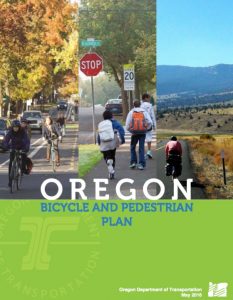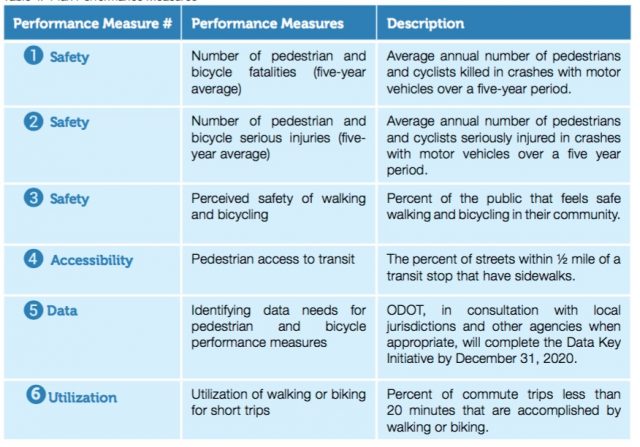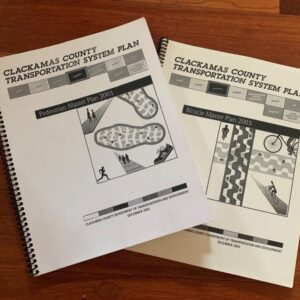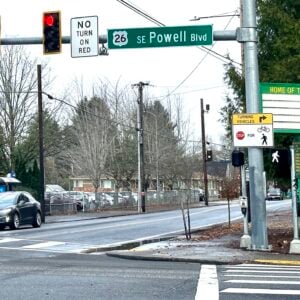
Oregon has a new statewide plan for bicycling and walking
A two-year planning process culminated at a meeting of the Oregon Transportation Commission on May 19th when commissioners voted to adopt the Oregon Bicycle and Pedestrian Plan (PDF).
The 80-page plan is one of four modal plans that set policy and strategy for the Oregon Department of Transportation. The old plan was adopted in 1995 and it was only a staff-level document. Now the plan is on the same internal level within ODOT as the state’s plans for rail, highway, and freight. “This raises the prominence and importance of biking and walking travel options with other modes and topics,” read a statement from ODOT last week. “Requiring explicit consideration and integration of biking and walking needs into transportation decisions across Oregon.”
Just how “explicit” the plan is has been a major point of contention.
In February we reported on how many regional advocates, leaders, and even ODOT’s own staff thought the plan needed stronger words in order to be effective.
“The plan needs to be precise and explicit regarding the statutory and regulatory basis for statewide bicycle and pedestrian policy,” wrote ODOT’s Region 1 Planning Manager Jon Makler in a letter last December with comments on a draft of the plan.

Advertisement

The adopted plan has made many changes to its policy language — moving from passive statements to more direct ones. In the Equity section for example, it used to read, “Seek opportunities to Integrate equity criteria into decision making,” and now it reads, “Integrate equity criteria…”. A small but important difference.
Another example of how the plan improved thanks to feedback is in Policy 3.3. An earlier draft of the plan cited a state statute (ORS 366.215) that says anything that reduces “vehicle-carrying capacity for freight trucks” must be discussed and approved before going forward. Former Oregon Bicycle and Pedestrian Advisory Committee member AJ Zelada said the inclusion of that statute was proof the plan had “no teeth“. Thankfully ODOT listened and the final plan has removed all references to ORS 366.215.
ODOT didn’t do everything advocates asked for. The Bicycle Transportation Alliance and other groups wanted specific corridors and streets to be named in the plan (similar to how ODOT has outlined specific trucking corridors in the Oregon Freight Plan). ODOT says they’ll define the network in a separate process.
But overall the BTA is pleased with how it turned out. Their Advocacy Director Gerik Kransky — who had called draft versions “absurd” and “offensive” — had a much softer tone about it today. “ODOT did a good job incorporating public feedback on their draft plan,” he wrote in an email to BikePortland. “I’m most excited about their commitment to implementation, which appears to contain some of what we were asking for while the plan was being developed.”
Kransky says he’s happy with the direction ODOT is going, especially after the announcement of several new hires in the active transportation division.
But as with all plans and proclamations, the proof will be in pudding. Will it actually lead to real changes?
ODOT also says they’re currently working on an Oregon Bicycle and Pedestrian Plan Implementation Work Program that will have more details on deliverables from the plan in the short, mid, and long-term.
“Several of the policies will immediately guide decision-making,” said ODOT’s Transportation Planning Unit Manager Amanda Pietz, “We will be taking the hard work people put into this plan and putting it into practice.”
Only time will tell.
— Jonathan Maus, (503) 706-8804 – jonathan@bikeportland.org
Our work is supported by subscribers. Please become one today.







Thanks for reading.
BikePortland has served this community with independent community journalism since 2005. We rely on subscriptions from readers like you to survive. Your financial support is vital in keeping this valuable resource alive and well.
Please subscribe today to strengthen and expand our work.
you reference ORS 366.125 but you meant ORS 366.215…
however, there are exceptions to safety and “access”… so both of those apply when adding bicycle facilities… I don’t see how they could use it as a scapegoat to not build non-motorized features…
thanks spiffy. typo has been fixed. And I don’t think the issue is that they’ll use it as a scapegoat directly… but it’s mere presence in the conversation could have acted as a barrier to moving forward and it could signify a lack of willingness of ODOT to do the right thing
The performance measure language is an improvement but there is still no discussion of infrastructure best practice for different roadway conditions. Expect more crappy bike lanes on high-speed roads.
Will the new process of specifying specific corridors take another 20 years?, at a rate of 3 months per page again?
I’m not sure how it could have taken so encredibly long to write such a vague nonspecific document.
An overhaul is needed.
This would have been a really good plan for Oklahoma or Kentucky or some other state that has to be delicate about trying to improve cycling due to a vocal opposition. It is a bafflingly limited plan for a state that likes to brag about its bike-friendliness, and a bizarrely radical plan document, if you’re interested in plans. An article should be written about the teeth that the 1995 plan included — such as mode share goals — that 2016 plan does not. And an article should be written about the strange, radical omissions of this plan, such as any maps at all. Seriously, actively refusing to include maps in a plan is really, really weird.
Nor do they label any of the photos, nor have captions of where the photo’s place is, or why it’s there. What a dumb document.
This plan looks like the crap that North Carolina used to produce (and still does locally). The latest official advice here from NCDOT is to literally throw the old 1994 state guidelines into the trash, and use the national NACTO guides instead. I’m surprised that ODOT is even issuing such a guide or plan.
When is a policy document like this going to explicitly reference climate change as one (additional) driver of transport diversification (=shift away from autos)? Other countries have been championing bicycles as a climate change avoidance strategy for eons. Why are our agencies such sticks in the mud?
Just as an example (this is from the German Umweltbundesamt, the equivalent of our EPA):
http://www.umweltbundesamt.de/themen/verkehr-laerm/nachhaltige-mobilitaet/radverkehr
And the page begins with the following statement (my translation):
Bicycling is fast, healthy, environmentally friendly, easy on the climate, affordable, timely, and worthy of support/sponsorship. Up to 30% of car trips could be displaced through bicycling.
Is there a special reason our state agencies cannot speak in direct, forceful, language like this?
American bureaucrats are trained to write in as passive language as possible. Anyone writing in an active voice is usually weeded out.
I don’t doubt that you are correct. But why is that? What can we do about it? I’m not satisfied that this is just how it is, especially if other jurisdictions have managed to avoid or counteract these unhelpful tendencies. Let’s challenge ourselves and our state agencies to do much, much better. Time’s a wasting. We don’t have another thirty years to screw around with this.
I co-wrote* the original plan in 1995. I’m eager to read this update.
The original in 1995 was a bold document. Nothing else like it had ever existed. My sense then was that it primarily served as a template to help smaller and rural communities understand good pedestrian and bicycle design. That is, if you’re in Klamath Falls and you want the city to improve an intersection you could point to the relevant page in the plan and say, “This, this is the design we want that integrates bicycles and pedestrians safely into the roadway.” Most small communities in Oregon don’t have the traffic engineers resources that Portland, Eugene, Ashland, etc. have.
Getting a plan that explicitly mandates all Oregon counties and cities to build infrastructure appropriately would be wonderful. Politically, that wasn’t really possible in 1995, nor is it in 2016. Telling rural Oregon it “must” build bicycle lanes is…a little scary. I’ve tried.
– Christian Kaylor
* co-wrote = My name is on it. I was in the room listening while smarter people (Rex Burkholder, Michael Ronkin and others) discussed it. I contributed very little, but I learned a lot.
One of the performance measures references “serious injuries”:
“Number of pedestrians and bicycle serious injuries (five-year average)”
The document goes on to clarify:
“A ‘serious injury’ is defined as an incapacitating injury, as reported by the responding law enforcement officer.”
This makes me wonder if there are any outreach efforts to law enforcement to ensure these type of injuries are accurately reported, or alternatively, if this reporting is already standard operating procedure.
It seems like it was written by lawyers. It’s more of a document to help defend against lawsuits like the one for 82nd, rather than an actual plan written by professional planners. I’m picturing some old dinosaurs smoking cigars and grumbling why they can’t just work on building freeways and how great it was back in the 60s when they were not being bugged abut occomodating pedestrians. Two words….early retirement. Please give someone else a chance, so we can start saving lives ( not just the ones driving cars ).